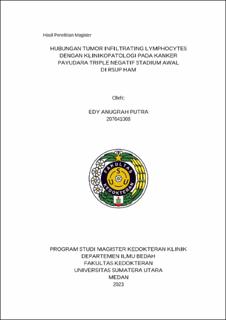| dc.description.abstract | Introduction: Triple-negative breast cancer is defined as the absence of estrogen, progesterone, and HER-2 receptors obtained by immunohistochemistry, with an incidence of 24% of newly diagnosed breast cancers. Several breast tumours have substantial lymphocytic infiltration, and tumour-infiltrating lymphocytes (TILs) are the potential surrogate markers of adaptive immune response and are positively associated with better survival in TNBC. This study examines the relationship between tumour infiltrating lymphocytes and clinicopathology in early-stage triple-negative breast cancer at HAM Hospital.
Methods: This research is an observational analytic study with a case series design where data collection was taken from secondary data using medical records. Inclusion criteria.
Results: The most common patient age group was between 31-40 years (52.7%), the most common tumour size was in the T2 category (63%), the most common nodule category was in the N1 category (35.6%), and Grade III (58.9%). In patients with early-stage triple-negative breast cancer, tumour-infiltrating lymphocytes in the moderate infiltration category (30-60%) were most commonly found (43.2%). A significant association between age, grade, and nodules for TIL was found with p <0.001.
Conclusion: A significant association was found between tumour infiltrating lymphocytes and age, grade and lymph node nodules in early-stage triple-negative breast cancer. | en_US |


